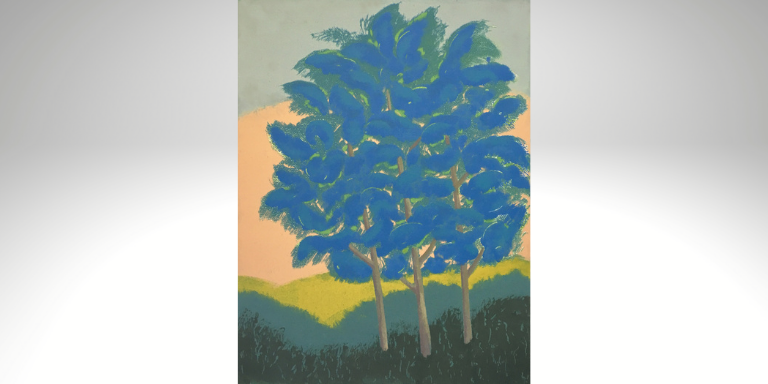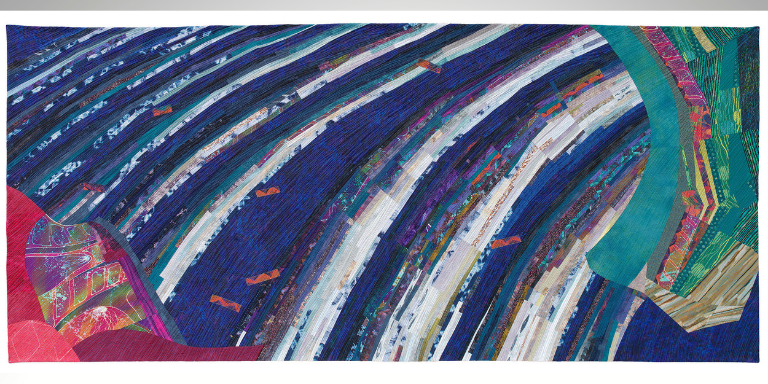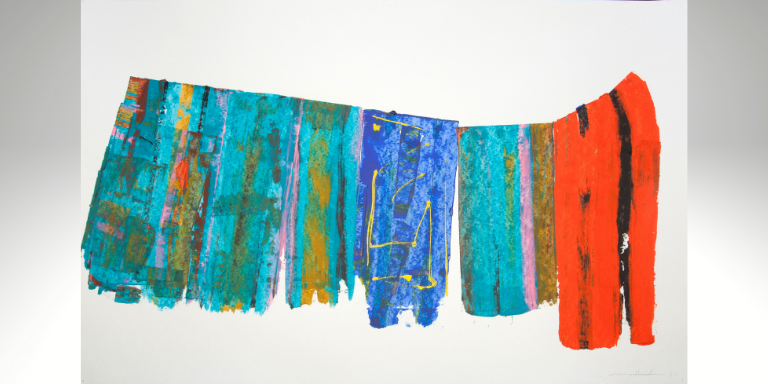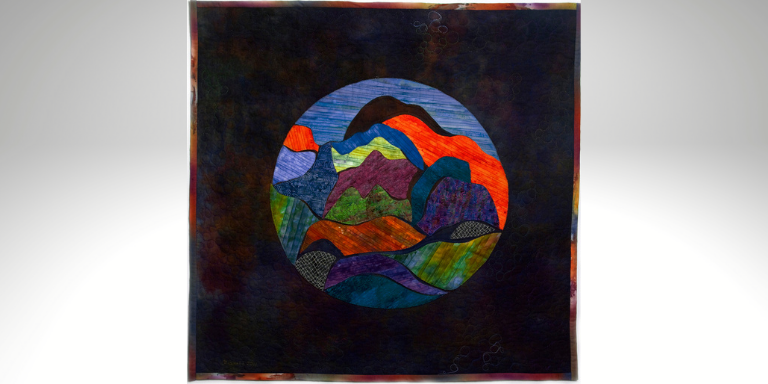Artwork on the third floor
Nora Akino:

My work arises from a feeling I often have when encountering nature in all its miraculous beauty: a longing to touch what is profound and mysterious, that is perhaps universal. The images are evocations of nature, refracted through the senses and my own cultural and personal affinities: in particular, the recognition of a boundless presence that permeates the natural world that expresses itself through the gestures of trees and clouds, the silence of mountain ranges. Longing for the far away and mysterious is really a longing to connect and learn and transform: human impulses that, for me, are the essence of the creative process. - Nora Akino
Nancy Bardach:

Rather than concrete reality, Bardach’s work tends to explore intangible qualities like light and movement. Color is also vital to her compositions. Color adds mood and emotional tone, lighting contrasts, a sense of movement and depth and, above all, great beauty to a piece. The most exciting pieces are those done quickly, intuitively, chasing a fleeting image --- and trying to realize its sensibility and beauty in the final pieced and stitched object. This urge, this aspiration, defines Bardach’ work. “A Song of Ascent” contains narrative ideas, abstracted into universal images. Retired after a 20-year career as an Architect in the Bay Area, Bardach is now a full-time fabric artist.
"A dispersed people may be leaving behond terror and war, or just natural disaster. Travelling towards a more hopeful future life … leaving behind an eternity of emptiness. Sea deep, and ocean-wide, m any perils confront migrants of all ages.
Departing from home and difficulty, hoping for the future. This piece speaks not only of the refugees’ sorrow, regrets, dangerous oceans, traversing dark spaces, but rather, of aspiration, arrival, inner hopes attained." - Nancy Bardach
Techniques: Curved and straight cutting, machine piecing. Long arm quilting by Angie Wooman, to a pattern of wave-like sunlit texturing designated by the artist.
Materials: Cotton fabrics including hand-painted batiks from Malaysia (by Turtle Hand); hand-dyes, commercial prints and batiks, batting, thread.
Emily Payne:

Emily Payne uses discarded books as a dominant medium in her work. She sees the aging book, like living things, existing in an ongoing state of decomposition. She mines old books for their parts, and transforms them into collaged, sculptural pieces, giving them new life. In Tumble, Emily cut apart book covers and glued them into a puzzle-like form that served as her canvas. Using the cream-colored end pages, with glimpses of the rich cloth covers peering through, she created a multi-layered composition out of gouache paint and graphite that is designed to be appreciated both from a distance and up close.
JM Golding:

My work explores the emotional and symbolic significance of the natural world as it reflects internal, subjective experience. Through the photograph, the world outside the person illuminates processes deep inside us that may not be readily accessible to awareness. I often see multilayered aspects of inner worlds in reflection, shadow, and multiple exposures. I work in lo-fi processes, primarily using traditional analogue methods, including Holga and other plastic cameras, pinhole cameras, and vintage film cameras. Using black and white film introduces an element of abstraction that lifts the image out of its specific context, universalizing the content and enriching its symbolic function. With plastic or toy cameras, there is a sense of spontaneity in the process of creating images, an invitation to move beyond control. I experience this spontaneity as promoting access to the emotional logic and metaphoric thought that are often just beyond immediate awareness. I made “Reaching for the light” and “Scene from an imagined childhood” using a Holga plastic camera. The images serve as visual metaphors for emotions arising from unconscious perception that is rooted in empathic connection. - JM Golding
Mike Henderson:

In his 2017 Parallel Spaces series, Mike Henderson returns to working with acrylic paint for the first time in 45 years. In contrast to his thickly layered oil paintings, Henderson’s application of paint here is sparse, almost sheer at times, framed and sometimes interrupted by negative space. Brightly hued vertical lines recall curtains or blinds, pulling apart here and there to reveal something just beyond. Here, the difference in approach grew from the character of acrylic paint, which dries more rapidly and is less flexible to mixing of colors as compared to oil paint, forcing the artist to work in quick and decisive motions. If Henderson’s paintings are a symphony, then his works on paper are a melody, singular but distinct. Parallel Spaces explores the notion of parallels; of the people, places, things and ideas that are opposite, apart yet analogous-and the liminal space in between. Henderson explains, “Every day we interact with life’s parallels. I have always been interested in what things are and what things are not, depending on the distance and awareness of the viewer; the parallels of knowing and not knowing, seeing and not seeing.” In these new works, Henderson examines the spaces that we inhabit, in parallel to nature and to one another, and what is revealed or concealed when these spaces shift and move. - Mike Henderson
Irene Imfeld:

These images of nature show a liminal environment where identity can be difficult to ascribe, between depiction and abstraction. I deliberately compose images in camera to alter later in the studio. My process causes a reduction of recognition but not of complexity. The abstracted imagery offers a unique view of the environment. The prints at Hayward Public Library are from two series, Zone of Transformation: Nature in the High Desert, and Phantasm: Autumn in the Kentucky Woods. These are counterpoints, contrasting the Eastern forests with Western desert. - Irene Imfeld
Barrie Rokeach:

Rokeach began his quest in aerial imagery after mastering the complexity of flight and the demands of photography, combining the two pursuits as a means of exercising the ultimate control over the medium. After decades of evaluating the aerial landscape and geomorphology as a metaphor of expression, Rokeach initiated an enquiry into the nature of the aerial perspective, analyzing the boundaries and presuppositions intrinsic to the medium, evidenced in some of his later work. Rokeach has flown across the United States and in a number of countries abroad. His aerial images have appeared in numerous museum and gallery exhibitions, hundreds of books and magazines, and in public and private collections. These hills, dotted with native oak trees, northeast of Livermore, California in late afternoon light, undulate sensuously adjacent to a small streambed.
Niambi Kee:

And on the Fifth Day (31x32): One of several themes that seem to inhabit my art is nature. I am mesmerized by its infinity of colors, textures and mysteries. And on the Fifth Day illustrates this as it attempts to suggest the creatures of the sky and those of the seas. (In between these two worlds are us humans who, in reality, have in comparison, minor differences in color, shape, size, voice. And we spend countless hours adorning, modifying, sculpting, torturing ourselves-yet never reaching their level of exquisite grace and beauty!). - Niambi Kee
Mary Marsh:
Just Waiting (23x28 each): A series of monoprints about reading, commuting and the intersection of mass media and personal habits. A linoleum-cut newspaper is a background for people reading, carved from sketchbook drawings done on my daily commute. Reading is a journey, can be an escape, and is a way to use the time while you are waiting to get somewhere else. I am looking at the quickly changing formats of our media with a mix of anxiety and nostalgia. - Mary Marsh
Kevin Keul:

Angled Salt Ponds: There is an inherent tension between beauty and devastation in my work. We have managed to manipulate our environment into shapes, patterns, textures, and colors by means of human consumption, manufacturing and expansion. Through my work, I reflect the physical footprints on our landscape and derive my visual resources and inspiration from satellite images of the earth's surface. Working from the pattern duality that is shared in both the macro perspective of aerial landscapes and the micro perspective of building materials, I create abstract compositions by combining views of these co-existing elements with marks left behind on the earth by the repeated process of building and rebuilding over time. In my studio, my practice mimics this scarification, “scratching, etching, burning and branding as a permanent skin modification,” through a physical application of these actions to the surfaces of various material in my work. - Kevin Keul


